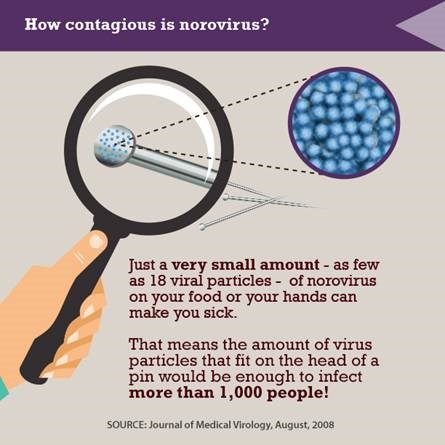News and Stories
Norovirus Season
The holiday season that starts in late fall/early winter brings many enjoyable, food- and family-filled events…but with this celebratory time also comes a spike in norovirus cases. Norovirus is the most common cause of foodborne-disease outbreak in the United States. Although you can contract it at any time of year, norovirus is most commonly spread during the colder months when outside temperatures cool and people congregate inside warm, closed spaces. It’s always important to be on alert for conditions that can spread this sometimes deadly, and always unpleasant bacteria.
People who are unfamiliar with the term norovirus may call it food poisoning or stomach flu. At work, schools, or throughout entire communities, you might hear talk of the stomach flu making its rounds. This is often because norovirus can survive for long periods outside of a human host depending on the surface and temperature conditions. It can remain alive for weeks on hard surfaces, up to 12 days on contaminated fabrics, and months to possibly years in contaminated still water.
What are the most common symptoms? Vomiting, diarrhea, and nausea with stomach pains top the list, but fever, headaches, and body aches are also typical. It’s important to realize that the virus is most contagious when a person is sick with vomiting and diarrhea, as well as during the first several days of recovery. Just a very small amount of norovirus—as few as 18 viral particles—on food or hands can make someone sick. In fact, the amount of virus particles that fit on the head of a pin would be enough to infect 1,000 people! Symptoms materialize suddenly, meaning an infected person may vomit in a public place and expose others. In fact, each year it causes 19-20 million illnesses, including 56,000-71,000 hospitalizations and 570-800 deaths, with the most at risk being children, pregnant women, the elderly, and the immunocompromised.
food or hands can make someone sick. In fact, the amount of virus particles that fit on the head of a pin would be enough to infect 1,000 people! Symptoms materialize suddenly, meaning an infected person may vomit in a public place and expose others. In fact, each year it causes 19-20 million illnesses, including 56,000-71,000 hospitalizations and 570-800 deaths, with the most at risk being children, pregnant women, the elderly, and the immunocompromised.
So how does this bug get passed around so easily? The three main means of transmission include person-to-person contact (with an infected source), contaminated food or water, and touching contaminated surfaces. That’s why it is critical for foodservice operators to train their staff well and maintain vigilance to avoid spreading the norovirus.
Markon has compiled the below guidelines and measures that can help your employees from spreading the particles and keep your customers safe.
Guidelines for Avoiding Norovirus
- Wash hands often
- When sick, don’t prepare food or care for others
- Wait two to three days after symptoms end before returning to work
- Wash hands often even after fully recovered
- Carefully wash fruits and vegetables
- Clean surfaces and wash laundry; wipe surfaces with bleach-based cleanser
- Cook shellfish thoroughly (140⁰F); norovirus can survive low cooking temperatures
Food Industry Measures
- Certify kitchen managers and train foodservice workers (https://www.servsafe.com/home) in food safety practices
- Adhere to food safety regulations
- Establish policies that require workers to stay home while sick with vomiting and diarrhea and at least 48 hours after symptoms end
- Foster a work environment that encourages workers to stay at home when sick
- Consider offering paid sick leave
- Implement staff plans that include on-call workers
- Make sure that foodservice employees practice proper hand washing and avoid touching ready-to-eat foods with bare hands
Foodservice Employee Measures
- Inform managers when sick with vomiting and diarrhea
- Immediately block off, clean, and disinfect areas where there has been a vomiting or diarrheal incident
- Wash hands carefully and often with soap and warm water for at least 20 seconds (the time it takes to sing the Happy Birthday song twice), especially after using the restroom
- Markon has online handwashing videos available in English, French, and Spanish to help you communicate the proper handwashing technique to your employees
- Use utensils and single-use disposable gloves to avoid touching ready-to-eat foods with bare hands
- Regularly clean and sanitize kitchen surfaces and frequently touched objects using a chlorine-based product or other sanitizers approved by the Environmental Protection Agency for use against norovirus
- Carefully wash fruits and vegetables
- Avoid serving undercooked (below 140°F) oysters and other shellfish
It’s important to keep your staffed informed and well-trained. For brochures and back-of-the-house posters with food safety tips—Markon has created these tools for your operation.
